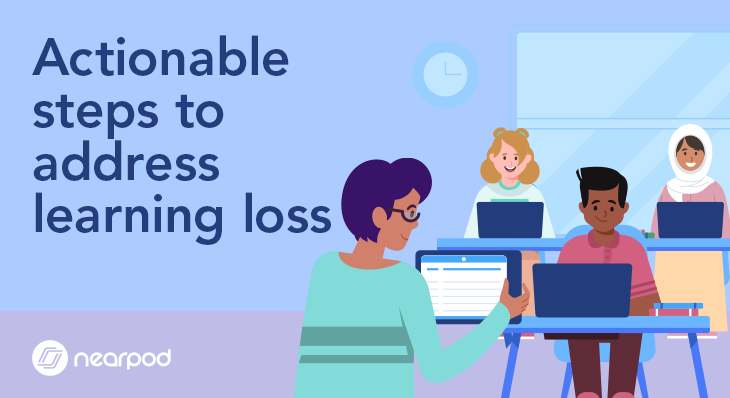
Actionable steps to address learning loss
It is more than likely that you’ve at least stumbled upon the word “learning loss” quite often in the past few months. Just Google the phrase and you’ll see a plethora of articles addressing the issue, debating the terminology, and suggesting strategies for moving forward. Learning loss, while not a new term, has been defined in a myriad of ways. The concept of loss or reversal of knowledge has been a concern for when kids are absent from school for extended periods of time — which might be from extenuating circumstances like illness, homelessness, or traveling. Learning loss is synonymous with the more familiar terms like “summer slump” or “summer slide,” which refers to the research indicating that kids can lose knowledge previously gained during summer vacation, often exacerbating the achievement gap.
The idea that learning declines if students aren’t engaged in it regularly is not a shocking reality. However, how these individuals are then supported going forward proves to be an ongoing challenge, especially given that the pandemic caused children globally to have an “extended” break from school with days missed or at the very least, greatly interrupted. In January 2021, UNESCO estimated that 800 million kids (>1/12 of the world’s student population) in 79 countries had already lost out on ⅔ of the academic year due to ongoing disruptions.
The effects of learning loss
McKinsey & Company has released a few reports, such as COVID-19 and learning loss—disparities grow and students need help (December 2020), COVID-19 and student learning in the United States: The hurt could last a lifetime(June 2020), and COVID-19 and education: The lingering effects of unfinished learning (July 2021) that encapsulate the widespread learning loss at the end of the 2020-2021 school year due to the COVID-19 pandemic:
- Students on average were four months behind in reading and five months behind in math
- Students in majority Black schools were left with six months of unfinished learning
- Students in low-income schools were left with seven months of unfinished learning
- High school dropout rates have increased
- High school seniors were less like to pursue higher education
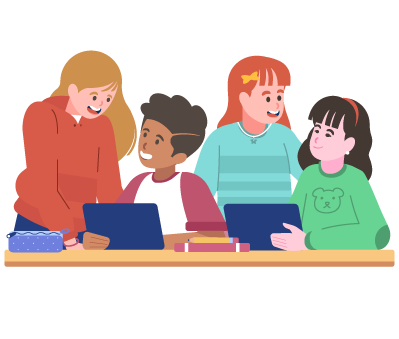
“Our analysis shows that the impact of the pandemic on K–12 student learning was significant, leaving students on average five months behind in mathematics and four months behind in reading by the end of the school year…The pandemic widened pre-existing opportunity and achievement gaps, hitting historically disadvantaged students hardest. In math, students in majority Black schools ended the year with six months of unfinished learning, students in low-income schools with seven.” (McKinsey)
An analysis from the Los Angeles Times further illustrated the discrepancy for Black, hispanic, and other “vulnerable” children already impacted by inequalities:
- The achievement gap that already existed widened as much as 21 percentage points
- While reading scores dropped 7 percentage points, the gap between Black and hispanic students and whites and Asians grew 26 percentage points
Innovate Public Schools released this infographic clearly illustrating the disparity found by McKinsey in December 2020:
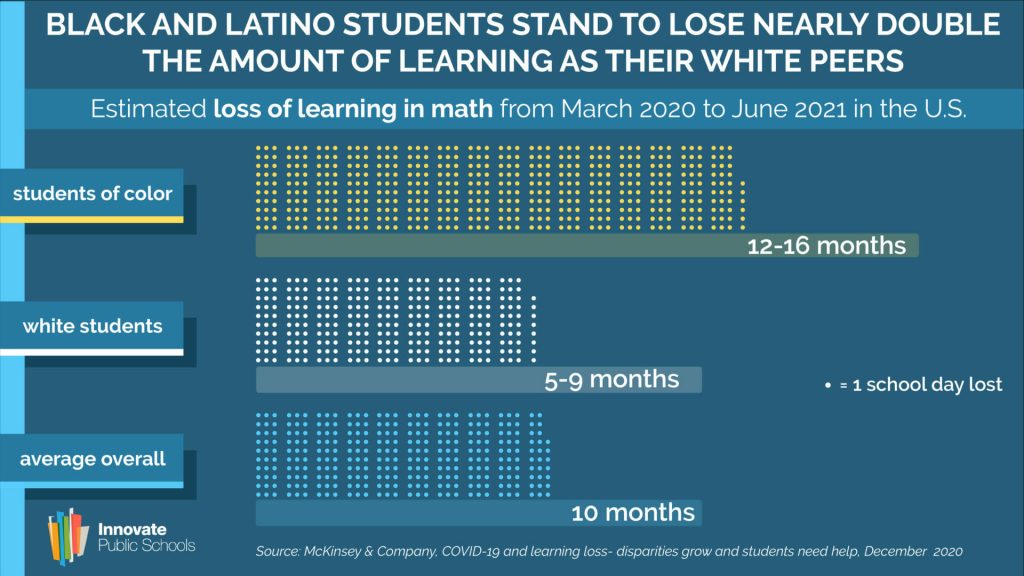
Once again, those with the least opportunities were impacted the most when it came to learning loss. And yet the losses aren’t just academic. Kids lost out on routines, consistency, and community. The toll has been great not only academically but socially and emotionally. Mental health issues have increased at alarming rates, even prompting the Children’s Hospital Colorado to declare a “State of Emergency” in youth mental health in May 2021.
Given these findings showing students behind in math and reading support, administrators should consider leveraging additional support through supplemental programs. Now more than ever, it’s important to prioritize quality and reliable math resources for teachers and students. Nearpod Math is a supplemental K-8 math program that provides the content, tools, and organization teachers need to maximize student learning and engagement in the math classroom. The program is designed to make math a positive learning experience by creating an active classroom learning environment where all voices are heard.
The various perspectives of learning loss
While there is no argument that kids have lost out in the pandemic, many argue that the term, learning loss, itself is a misnomer, and that it positions the kids in having an uphill battle. They argue that the term insinuates that the kids are operating from a deficit perspective; that they have a lot to “make up for” due to opportunities never experienced. Instead, some prefer the terms unfinished learning or unfinished instruction, interrupted learning, learning lag, or the more general COVID academic slide.
It is loss of a previously imagined trajectory leading to a previously imagined future. Learning is never lost, though it may not always be “found” on pre-written tests of pre-specified knowledge or preexisting measures of pre-coronavirus notions of achievement.
Rachael Gabriel, Washington Post
While subtle, the shift in languages takes the onus away from being a deficit-focused approach to help establish a healthier approach of meeting the kids where they are. No longer is the tone helpless or defeatist about no learning taking place or that previous learning was lost. There is less pressure to “double down.” Plus, it broadens the conversation to be about more than just academic measures.
“Loss” also implies a focus on quantity versus quality. Some argue that kids did in fact learn a lot during the pandemic — but that the lessons were different than the traditional. For some, they learned the value of good neighbors, for others they learned a bit more patience and flexibility, and some learned some new tech-savvy skills.
With a glass-is-half-full approach, we can look at how online learning was enriching. Many kids did flourish with the choice, freedom, and flexibility of remote learning. Such learning model options can bolster empowerment, fuel connections, inspire imaginations, and provide a sense of purpose for all ages. This sense of confidence and autonomy can be foundational for life’s challenges.
Actionable steps to address learning loss
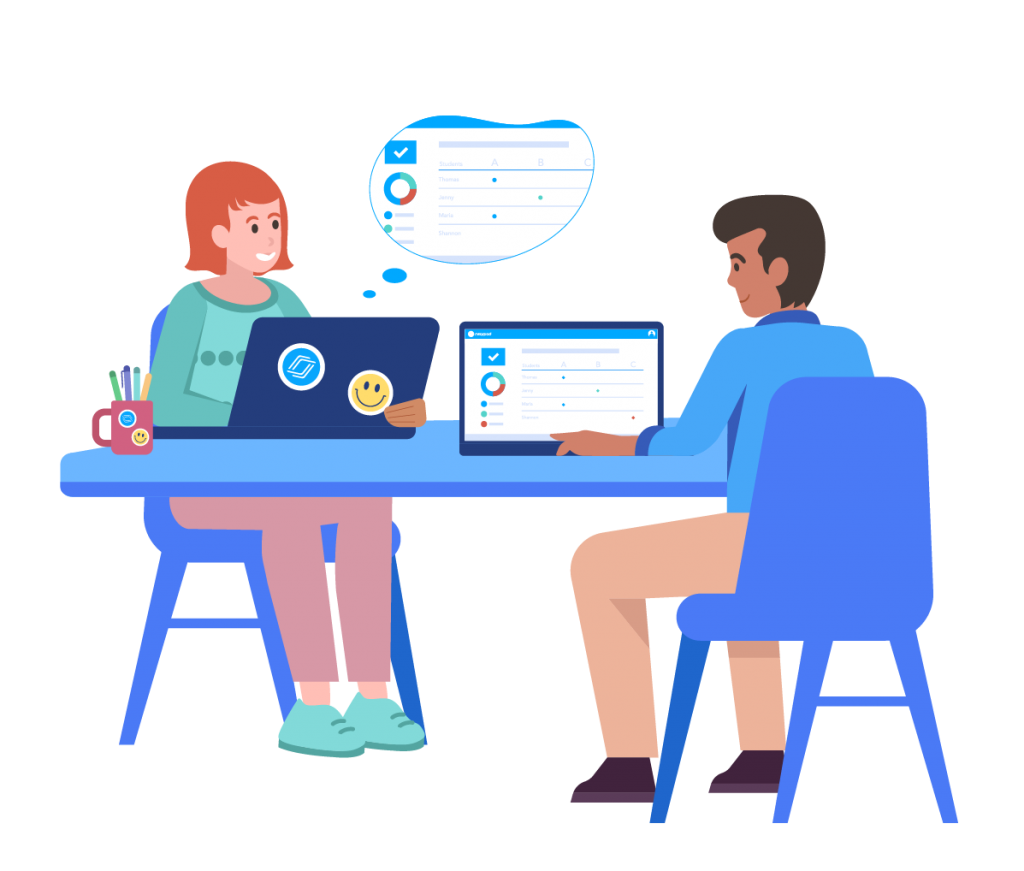
But regardless of where you fall in this debate, we know that our kids need more support moving forward to re-embrace schooling and continue to blaze their own personal learning paths. The debate underscores the need to have more meaningful conversations about what constitutes learning or schooling (or even unlearning and unschooling).
So what are school leaders to do?
1. First, steep yourself in the debate.
Reflect on your beliefs and where they come from. Read others’ perspectives to understand the thinking on both sides so that you can empathize with the variety of opinions and design solutions to support all.
2. Next, survey the stakeholders in your school community: staff, students, and their families.
What are they most concerned about? What are they appreciative of? Consider a schoolwide survey and develop a task team to represent all stakeholders. Implore them to rely on both quantitative and qualitative data to inform recommended next steps.
3. Then, take a step back and look at your school’s learning ecosystem.
Do you have a dynamic curriculum? How recently has it been updated? How can you fold in some of the best of the edtech you relied on during remote learning to make your schoolwide processes and practices more responsive and engaging?
4. Next, determine a short-term and long-term plan of action.
What should you do tomorrow versus next semester or next year? Organizations like ASCD suggest returning to basics:
- Revisit instructional design strategies to increase engagement
- Focus on small group instruction
- Devote additional time to early literacy skills
- Consider volunteer or additional reading support and math resources for staff
- Commit to ongoing teacher-student mini conferences
- Team teach across subjects
- Vertically plan across grade levels
- Leverage the best of edtech
- Hold regular PTA or town hall type of convening
5. Lastly, yet most importantly in many ways, do take stock of your services to support kids’ whole growth, including mental health.
ASCD reports that some researchers have coined “the thriving gap” to speak to the effects of the pandemic and the need for academic and SEL support moving forward. Make sure your action plan has ways to bolster current resources or partner with community-based organizations to increase resources for kids, staff members, and families. Without such whole-child support, no child will be set up for academic success.
Moving forward

“But well-being isn’t just a prelude to learning or a simple support for it. Well-being is an integral part of academic learning. If we treat well-being as being only about safety, security, and protection from harm, we’re ignoring the higher levels of Maslow’s hierarchy, where well-being and inspired teaching go hand in hand.”
ASCD
No one can anticipate such disasters as a pandemic occurring, but we can learn from reflecting on what worked the best in the moment and adjusting in the name of improving education as children’s ongoing needs will continue to shift and change. Likewise, whatever the contributors are when it comes to learning loss (or which term you prefer), we must continue to find new methodology and practices to (re)engage kids in becoming fearless, lifelong learners. We need to provide all students with opportunities to challenge themselves, so that they become their own driving force for pursuing continued learning and reaching their personal goals.
Learning loss has widened the achievement gap in math and ELA across the U.S.. Find out how Nearpod can support your teachers with engaging learning experiences that maximize outcomes for all learners.
Interested in reading more about this topic? Check out this blog post: Supporting Educators’ SEL: How Social and Emotional Learning is a Lifelong Journey
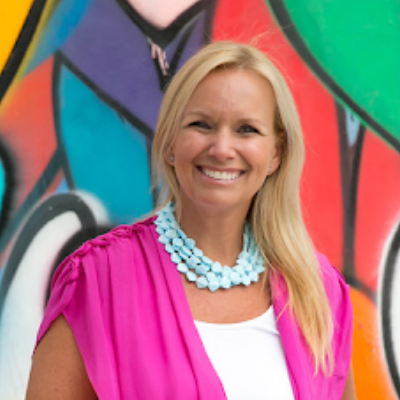
Darri Stephens is a dedicated LX (learning experience) designer, passionate about creating quality content and programs for kids, families, and educators. With MAs in Education from both Harvard and Stanford, and work experience at best-in-class ed tech organizations including Wonder Workshop, Nickelodeon, and Common Sense Education, she is steeped in the design thinking process and committed to agile and iterative project management, which has resulted in multi-award-winning programs and products.








